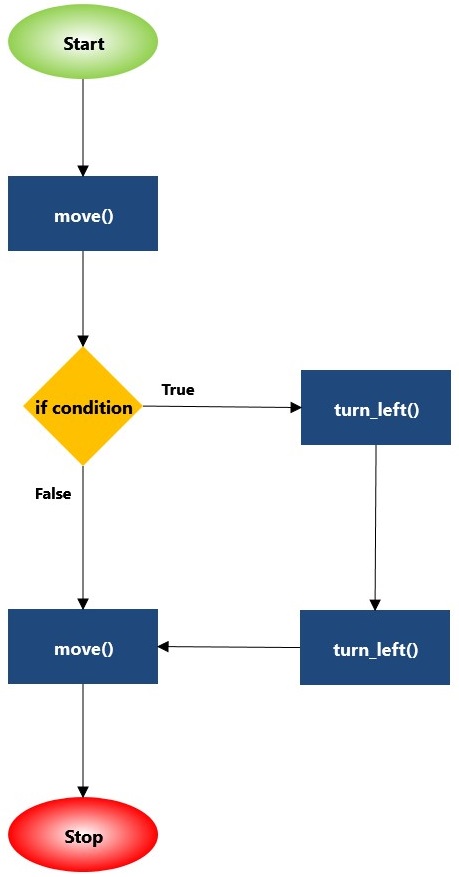Step 8: Asking Questions¶
CS20-CP1 Apply various problem-solving strategies to solve programming problems throughout Computer Science 20.
CS20-CP2 Use common coding techniques to enhance code elegance and troubleshoot errors throughout Computer Science 20.
CS20-FP2 Investigate how control structures affect program flow.
CS20-FP3 Construct and utilize functions to create reusable pieces of code.
Tutorial¶
Sometimes, we don’t know ahead of time exactly what the world that Reeborg is going to be faced with will look like. Thankfully, Reeborg can sense the world around it, and we can ask Reeborg questions about it. To ask the computer a question, we use an if statement.
if some_condition:
# block of code
There are special functions that Reeborg recognizes that allow Reeborg to make decisions. The first of these is object_here() which tells Reeborg if there is at least one object at the grid position where it is located. For example, if we want to ask Reeborg to collect objects (dandelions, carrots, etc), one part of the code could be:
if object_here():
take()
The complete list of functions (questions) that Reeborg can answer is as follows:
Question/Function |
Explanation |
|---|---|
at_goal() |
Returns True if Reeborg is on a goal tile (flag, home, or green tile), False otherwise. |
front_is_clear() |
Returns True if there is no obstacle (wall, etc) in front of Reeborg, False otherwise. |
right_is_clear() |
Returns True if there is no obstacle (wall, etc) to the right of Reeborg, False otherwise. |
wall_in_front() |
Returns True if there is a wall in front of Reeborg, False otherwise. |
wall_on_right() |
Returns True if there is a wall on the right side of Reeborg, False otherwise. |
object_here() |
Returns True if there is an object (star, dandelion, etc) on the same tile as Reeborg is standing on, False otherwise. |
carries_object() |
Returns True if Reeborg is currently carrying at least one object (star, dandelion, etc). Returns False if Reeborg is carrying nothing. |
is_facing_north() |
Returns True if Reeborg is currently facing north, False otherwise. |
Any time you want to ask Reeborg about the world around it, you can use an if statement with one of these questions. For example, if you only wanted to move forward if you won’t crash into something, you could use the following:
if front_is_clear():
move()
Your Turn¶
Open Step 8 on the Reeborg environment.

Reeborg’s friend Bree loves to pick dandelions and blow the seeds as far as she can. Because of this, Reeborg often finds dandelions growing in the front yard. The dandelions aren’t always in the same spot, though. To see this, press the play button on the Step 8 world, and notice that dandelions appear in different places each time. You can tell that this is going to happen because of the black question mark underneath the image of the dandelion.
Create a program to have Reeborg walk across the front yard, picking up a dandelion whenever it finds one. There might be a dandelion in any of the locations that have a dandelion image with a question mark underneath (you can see this again if you press the reload button). You will need to ask Reeborg questions as it moves across the front yard. Once every possible dandelion is picked up, have Reeborg put down all the dandelions it has picked up at (2,3), then return to the flag (1,3). Remember to use comments and whitespace to increase the readability of your solution!
If You’re Having Trouble (a more detailed explanation)¶
Say you wanted Reeborg move twice, but there might be a wall in front of it after the first move. If there is a wall, you want Reeborg to turn around before the second move. You could do this with the following code:
move()
if wall_in_front():
turn_left()
turn_left()
move()
You can think of the above using a flowchart, if it helps:
